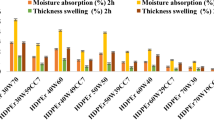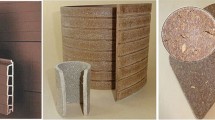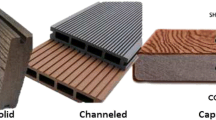Abstract
Wood-plastic composites (WPC) can incorporate up to 80% wood fibres, which reduces the use of scarce oil resources for plastic production. To increase the interest of industrial deciders in applying WPCs in the building sector, for example in façades, application-oriented basic research on thermoplastic shaping after hot-pressing of already produced sheets is necessary. This review paper reports on a comprehensive analysis of the current state of research on basic temperature-related WPC properties such as thermal conductivity, heat storage capacity and thermal expansion. In addition, it discusses geometric material specifications, which play a role when WPC sheets become thermoformed and sculptured for three-dimensional façade applications. It is demonstrated that WPCs offer interesting potential to positively regulate the interior climate of a building, and that other components, such as phase change materials (PCM), can be effectively combined with this biobased composite. In terms of geometric design options there is still a lack of research about minimum bending radii and potential shape memory effects of WPCs after re-heating and cooling. Finally, this paper provides recommendations on which experimental studies are necessary to close these research gaps and which hypotheses are to be tested. With the knowledge to be generated, a successful development of three-dimensional WPC products in industrial mass production becomes feasible.






Similar content being viewed by others
Data availability
The raw/processed data required to reproduce these findings cannot be shared at this time as the data also forms part of an ongoing study.
Code availability
Not applicable.
References
Agoua E, Allognon-Houessou E, Adjovi E, Togbedji B (2013) Thermal conductivity of composites made of wastes of wood and expanded polystyrene. Constr Build Mater 41:557–562
Baetens R, Jelle BP, Gustavsend A (2019) Phase change materials for building applications: a state-of-the-art review. Energy Build 42:1361–1368
Carus M, Eder A (2015) WPC and NFC market trends, bioplastics. Magazine 10:12–13
Carus M, Vogt D, Ortmann S, Schmidt C, Gahle C (2020) Wood-plastic composites (WPC)—markets, technical properties, application areas, prices, players (translated form German). Nova-Institut, Hürth
Chang SJ, Wi S, Cho HM, Jeong SG, Kim S (2020) Numerical analysis of phase change materials/wood-plastic composite roof module system for improving thermal performance. J Ind Eng Chem 82:413–423
Chen L, Song N, Shi L, Ding P (2018) Anisotropic thermally conductive composite with wood-derived carbon scaffolds. Compos A 112:18–24
de Gracia A, Cabeza LF (2015) Phase change materials and thermal energy storage for buildings. Energy Build 103:414–419
Fiorito F, Sauchelli S, Arroyo D, Pesenti M, Imperadori M, Masera G, Ranzi G (2016) Shape morphing solar shadings: a review. Renew Sustain Energy Rev 55:863–884
Friedrich D (2016a) Investigations on ageing of wood-plastic composites for outdoor applications: a meta-analysis using empiric data derived from diverse weathering trials. Constr Build Mater 124:1142–1152
Friedrich D (2016b) Measuring the wind suction capacity of plastics-based cladding using foil bag tests: a comparative study. J Build Eng 8:152–161
Friedrich D (2019) Using PVC-based wood-plastic composites in window frames—studying performance and benefits. Profiles—international conference on plastic profiles for construction applications, 12–13 November, 2019, Cologne
Friedrich D (2020) Angewandte Bauphysik und Werkstoffkunde naturfaserverstärkter Kunststoffe: Eine Anleitung für Studium und Praxis (Applied building physics and materials science of natural fibre-reinforced plastics: a guide for study and practice). Springer. https://doi.org/10.1007/978-3-658-30938-1
Friedrich D (2021) Thermoplastic moulding of wood-polymer composites (WPC): a review on physical and mechanical behaviour under hot-pressing technique. Compos Struct 262:113649
Guarino F, Dermardiros V, Chen Y, Rao J, Athienitis A, Cellura M, Mistretta M (2015) PCM thermal energy storage in buildings: experimental study and applications. Energy Procedia 70:219–228
Guo X, Cao J, Peng Y, Liub R (2016) Incorporation of microencapsulated dodecanol into wood flour/high-density polyethylene composite as a phase change material for thermal energy storage. Mater Des 89:1325–1334
Guo X, Zhang L, Cao L, Peng Y (2017) Paraffin/wood flour/high-density polyethylene composites for thermal energy storage material in buildings: a morphology, thermal performance, and mechanical property study. Polym Compos 39(S3):E1643–E1652. https://doi.org/10.1002/pc.24593
Huang R, Xu X, Lee S, Zhang Y, Kim BJ, Wu Q (2013) High density polyethylene composites reinforced with hybrid inorganic fillers: morphology, mechanical and thermal expansion performance. Materials 6:4122–4138. https://doi.org/10.3390/ma6094122
Inomata K, Nakagawa K, Fukuda C, Nakada Y, Sugimoto H, Nakanishi E (2010) Shape memory behavior of poly(methyl methacrylate)-graft-poly(ethylene glycol) copolymers. Polymer 51:793–798
Jamekhorshid A, Sadrameli SM, Barzin R, Farid MM (2017) Composite of wood-plastic and micro-encapsulated phase change material (MEPCM) used for thermal energy storage. Appl Therm Eng 112:82–88
Jingchen X, Keyan Y, Yucheng Z, Yuxiang Y, Jianmin C, Liping C, Sheldon SQ (2020) Form-stable phase change material based on fatty acid/wood flour composite and PVC used for thermal energy storage. Energy Build 209:109663
Kaymakci A, Ayrilmis N, Gulec T (2013) Surface properties and hardness of polypropylene composites filled with sunflower stalk flour. BioResources 8:592–602
Knippers J, Speck T (2012) Design and construction principles in nature and architecture. Bioinspiration Biomim 7:015002
López M, Rubio R, Martín S, Croxford B (2017) How plants inspire façades. From plants to architecture: biomimetic principles for the development of adaptive architectural envelopes. Renew Sustain Energy Rev 67:692–703
Martins G, Antunes F, Mateus A, Malça C (2017) Optimization of a wood plastic composite for architectural applications. Procedia Manuf 12:203–220
Mazzanti V, Mollica F (2020) Bending properties of wood flour filled polyethylene. Procedia Eng 200:68–72. https://doi.org/10.1016/j.matpr.2019.11.062
Mazzanti V, Mollica F, Kissi NE (2014) Rheological and thermal properties of PP-based WPC. AIP Conf Proc 1599:274–277. https://doi.org/10.1063/1.4876831
Meyer BC, Katsiropoulos CV, Pantelakis SG (2009) Hot forming behavior of non-crimp fabric peek/c thermoplastic composites. Compos Struct 90:225–232
Naghipour M, Nematzadeh M, Yahyazadeh Q (2011) Analytical and experimental study on flexural performance of WPC-FRP beams. Constr Build Mater 25:829–837
Omrany H, Ghaffarianhoseini A, Ghaffarianhoseini A, Raahemifard K, Tookey J (2016) Application of passive wall systems for improving the energy efficiency in buildings: a comprehensive review. Renew Sustain Energy Rev 62:1252–1269
Połec IA, Hine PJ, Bonner MJ, Ward IM, Barton DC (2012) Hydro and thermal stability of die drawn wood polymer composites in comparison to solid wood. Compos Sci Technol 72:1436–1442
Pöllänen M, Suvanto M, Pakkanen T (2013) Cellulose reinforced high density polyethylene composites—Morphology, mechanical and thermal expansion properties. Compos Sci Technol 76:21–28
Prisco U (2014) Thermal conductivity of flat-pressed wood plastic composites at different temperatures and filler content. Sci Eng Compos Mater 22:197–204
Rahman KS, Islam N, Rahman M, Hannan O, Dungani R, Khalil A (2013) Flat-pressed wood plastic composites from sawdust and recycled polyethylene terephthalate (PET): physical and mechanical properties. Springerplus 2:629
Rezanejad S, Kokabi M (2007) Shape memory and mechanical properties of cross-linked polyethylene/clay nanocomposites. Eur Polymer J 43:2856–2865
Royan NR, Sulong AB, Yuhana NY, Chen RS, Hafizuddin M, Ghani A, Ahmad S (2018) UV/O3 treatment as a surface modification of rice husk towards preparation of novel biocomposites. PLoS One 13:e0197345
Sadineni SB, Madala S, Boehm RF (2011) Passive building energy savings: a review of building envelope components. Renew Sustain Energy Rev 15:3617–3631
Schmidt H, Benthien J, Thoemen H (2013) Processing and flexural properties of surface reinforced flat pressed WPC panels. Eur J Wood Prod 71:591–597
Smith PM, Wolcott MP (2006) Opportunities for wood/natural fiber-plastic composites in residential and industrial applications. For Prod J 56:44–11
Sombatsompop N, Wood AK (1997) Measurement of thermal conductivity of polymers using an improved Lee’s disc apparatus. Polym Test 16:203–223
Soury E, Behravesh AH, Esfahani ER, Zolfaghari A (2009) Design, optimization and manufacturing of wood-plastic composite pallet. Mater Des 30:4183–4191
Tatsuno D, Yoneyama T, Kawamoto K, Okamoto M (2018) Hot press forming of thermoplastic CFRP sheets. Procedia Manuf 15:1730–1737
Thomason JL, Groenewoud WM (1996) The influence of fibre length and concentration on the properties of glass fibre reinforced polypropylene 2. Thermal properties. Compos A Appl Sci Manuf 27:555–565
Toghyani AE, Amraei M, Matthews S, Varis J, Kärki T, Zhao XL (2017) Effect of strain rate and temperature on press forming of extruded WPC profiles. Compos Struct 180:845–852
Trigui A, Karkri M, Boudaya C, Candau Y, Ibos L (2013) Development and characterization of composite phase change material: thermal conductivity and latent heat thermal energy storage. Compos Part B 49:22–35
Walcott P (2003) Formulation and process development of flat-pressed wood-polyethylene composites. For Prod J 53(9):25–32
Wang L, He C (2019) Characterization of rice husk fiber-reinforced polyvinyl chloride composites under accelerated simulated soil conditions. Int J Polym Sci 2019:5409821. https://doi.org/10.1155/2019/5409821
Wethyavivorn B, Surit S (2011) Design development of wood-plastic for building louver façade. Procedia Eng 21:147–154
Wu Q, Chi K, Wu Y, Lee S (2014) Mechanical, thermal expansion, and flammability properties of co-extruded wood polymer composites with basalt fibre reinforced shells. Mater Des 60:334–342
Xie T (2011) Recent advances in polymer shape memory. Polymer 52:4985–5000
Yang YK, Kim MY, Chung MH, Park JC (2019) PCM cool roof systems for mitigating urban heat island—an experimental and numerical analysis. Energy Build 205:109537
Zhang X, Hao X, Hao J, Wang Q (2018) Heat transfer and mechanical properties of wood-plastic composites filled with flake graphite. Thermochim Acta 664:26–31
Zhao Q, Zou W, Luo Y, Xie T (2016) Shape memory polymer network with thermally distinct elasticity and plasticity. Sci Adv 2:e1501297
Norms/Regulations
ASTM C518-10 (2010) Standard test method for steady-state thermal transmission properties by means of the heat flow meter apparatus. Replaced by ASTM C518-17. ASTM International, West Conshohocken
EU 305:2011. Regulation (EU), No 305/2011 of the European Parliament and of the Council laying down harmonized conditions for the marketing of construction products and repealing Council Directive 89/106/EEC
DIN EN ISO 178:2019-08. Plastics—determination of flexural properties. German Institute for Standardization, Berlin
Acknowledgements
The author gratefully acknowledges the collaborative work with Prof. Dr. Rosemarie Wagner, Institute of Architecture at Karlsruhe Institute of Technology (KIT), where he conducts further research in the topics based on this review paper. The author also acknowledges the work of the COST ACTION CA 16114 “RESTORE” funded by the European Commission, where he researches biobased plastic composite materials labelled as Compolytics (composite polymer and policy analytics) research.
Funding
This research did not receive any specific grant from funding agencies in the public, commercial or not-for-profit sectors.
Author information
Authors and Affiliations
Contributions
The corresponding author contributed to the design and implementation of the research, to the analysis of the results and to the writing of the manuscript.
Corresponding author
Ethics declarations
Conflict of interest
No conflicts to declare.
Additional information
Publisher's Note
Springer Nature remains neutral with regard to jurisdictional claims in published maps and institutional affiliations.
Rights and permissions
About this article
Cite this article
Friedrich, D. Thermoplastic moulding of wood-polymer composites (WPC): a review and research proposal on thermo-physical and geometric design options using hot-pressing. Eur. J. Wood Prod. 80, 7–21 (2022). https://doi.org/10.1007/s00107-021-01767-2
Received:
Accepted:
Published:
Issue Date:
DOI: https://doi.org/10.1007/s00107-021-01767-2




